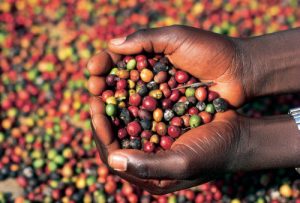June coffee prices offer producers little confidence
July 11—The coffee market in June was characterized by high volatility eventually resulting in a sideways move of coffee prices, according to the latest report from the International Coffee Organization (ICO).
While the monthly average of the ICO composite indicator prices was down 2.4 per cent to 122.39 US cents per pound (nearly $250/kilo), the difference in price between the opening and the end of the month was minimal, the report found.
In the first two weeks of June, the daily price of the composite indicator remained in a relatively narrow band of 122.11 to 124.55 US cents per pound. Subsequently prices dropped significantly, with the indicator price reaching its low of 116.51 US cent/lb on 22 June. The price recovered, making up for virtually all the losses and recorded 123.83 US cents per pound on 30 June, marginally higher than at the beginning of the month.
The ICO’s breakdown by group indicators reveals that an increase in Robusta prices, especially in the second half of June, buffered a drop in prices of the Arabica Groups, preventing the composite indicator price from turning even more negative.
Robustas recorded a strong increase, up by 3.6 per cent compared to the previous month and returning above the 100 US cents per pound mark, following reports about thinning exports from Vietnam. All three Arabica groups in turn registered significant drops as the average prices for Colombian Milds, Other Milds and Brazilian Naturals were down 3.5 per cent, 4.5 per cent and 5.7 per cent, respectively.
As a result of the opposing trends in Arabica and Robusta quotations, the arbitrage, as measured on the New York and London futures markets, decreased significantly by 22.2 per cent to 35.07 US cents per pound, the narrowest level since April 2008.
Total exports in May came to 10.9 million bags, 8.8 per cent higher than May 2016. During the first eight months of coffee year 2016/17 total exports are 3.9 million bags higher than last year, when shipments amounted to 77.4 million bags. Exports by Brazil have declined for two consecutive years and are 22.7 million bags in 2016/17, down 5.9 per cent compared to the previous year.
However, the decrease was lower than expected despite the relatively poor harvest, as exporters drew heavily on existing stocks. Furthermore, the reduced Brazilian export volume could be compensated by shipments from other origins.
Notably, Colombia, Ethiopia, Honduras, Indonesia, Peru and Uganda are positioned to potential supply gap. As the national authorities’ renovation programmes continue to bear fruit, Colombia has increased exports up to 9.2 million bags, 7.2 per cent more than in the October‐May period last year.
Indonesia recorded an impressive 2.3 million bag increase (+60 per cent) compared to the previous year, while Honduras’ exports were 30 per cent higher than in 2015/16.
Shipments from Vietnam are estimated to have decreased by more than a quarter from 2.5 million bags in April 2017 to 1.9 million bags in May. Reports suggest that coffee exporters now see their local supply increasingly squeezed due to the previous small crop. Nevertheless, the October‐May exports are estimated at slightly above 17 million bags, similar to the previous year.
As a result of high export volumes so far during this coffee year and the build‐up of large inventories in importing countries, the market remains well supplied. The sudden drop in prices during the third week of June seems to have been triggered by co‐movement of coffee and other soft commodities, as some reports about technical selling suggest.
However, moving into the month of July, the ICO said there is still a residual risk of frost in Brazil potentially affecting the outlook for the next crop. Similarly, possible outbreaks of coffee leaf rust in countries such as Honduras may raise supply concerns in the market.


 African Heads of state head to South Korea next week for Summit talks
African Heads of state head to South Korea next week for Summit talks
 Trading leads as main source of income for Ugandans
Trading leads as main source of income for Ugandans
 New leadership for bankers’ umbrella as total assets top $12 billion
New leadership for bankers’ umbrella as total assets top $12 billion
 Brussels Airlines to announce Nairobi service
Brussels Airlines to announce Nairobi service
 SITA promises enhanced travel experience after Materna acquisition
SITA promises enhanced travel experience after Materna acquisition
 Saudia’s 105 aircraft order stretches A320neo lead over rival Max
Saudia’s 105 aircraft order stretches A320neo lead over rival Max
